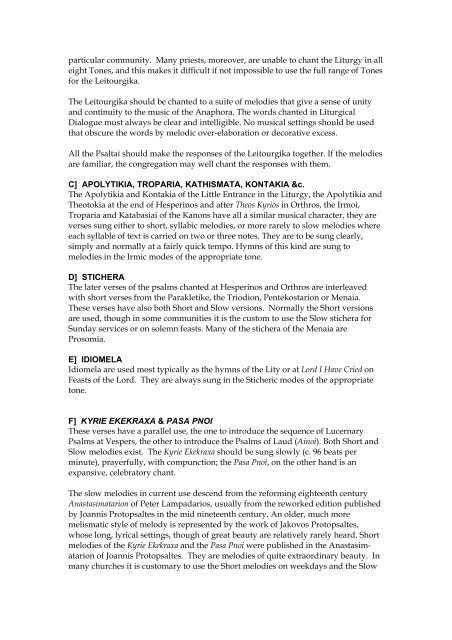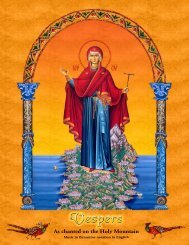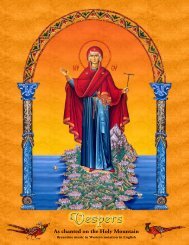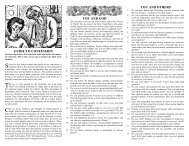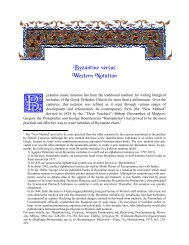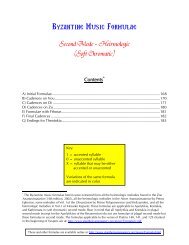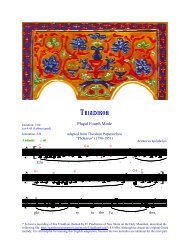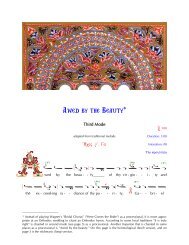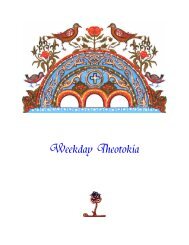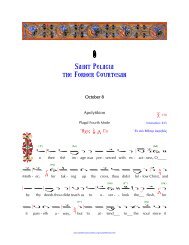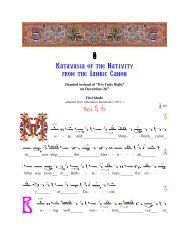Reading Psalmodia (PDF) - St. Anthony's Monastery
Reading Psalmodia (PDF) - St. Anthony's Monastery
Reading Psalmodia (PDF) - St. Anthony's Monastery
Create successful ePaper yourself
Turn your PDF publications into a flip-book with our unique Google optimized e-Paper software.
particular community. Many priests, moreover, are unable to chant the Liturgy in alleight Tones, and this makes it difficult if not impossible to use the full range of Tonesfor the Leitourgika.The Leitourgika should be chanted to a suite of melodies that give a sense of unityand continuity to the music of the Anaphora. The words chanted in LiturgicalDialogue must always be clear and intelligible. No musical settings should be usedthat obscure the words by melodic over-elaboration or decorative excess.All the Psaltai should make the responses of the Leitourgika together. If the melodiesare familiar, the congregation may well chant the responses with them.C] APOLYTIKIA, TROPARIA, KATHISMATA, KONTAKIA &c.The Apolytikia and Kontakia of the Little Entrance in the Liturgy, the Apolytikia andTheotokia at the end of Hesperinos and after Theos Kyrios in Orthros, the Irmoi,Troparia and Katabasiai of the Kanons have all a similar musical character, they areverses sung either to short, syllabic melodies, or more rarely to slow melodies whereeach syllable of text is carried on two or three notes. They are to be sung clearly,simply and normally at a fairly quick tempo. Hymns of this kind are sung tomelodies in the Irmic modes of the appropriate tone.D] STICHERAThe later verses of the psalms chanted at Hesperinos and Orthros are interleavedwith short verses from the Parakletike, the Triodion, Pentekostarion or Menaia.These verses have also both Short and Slow versions. Normally the Short versionsare used, though in some communities it is the custom to use the Slow stichera forSunday services or on solemn feasts. Many of the stichera of the Menaia areProsomia.E] IDIOMELAIdiomela are used most typically as the hymns of the Lity or at Lord I Have Cried onFeasts of the Lord. They are always sung in the <strong>St</strong>icheric modes of the appropriatetone.F] KYRIE EKEKRAXA & PASA PNOIThese verses have a parallel use, the one to introduce the sequence of LucernaryPsalms at Vespers, the other to introduce the Psalms of Laud (Ainoi). Both Short andSlow melodies exist. The Kyrie Ekekraxa should be sung slowly (c. 96 beats perminute), prayerfully, with compunction; the Pasa Pnoi, on the other hand is anexpansive, celebratory chant.The slow melodies in current use descend from the reforming eighteenth centuryAnastasimatarion of Peter Lampadarios, usually from the reworked edition publishedby Joannis Protopsaltes in the mid nineteenth century. An older, much moremelismatic style of melody is represented by the work of Jakovos Protopsaltes,whose long, lyrical settings, though of great beauty are relatively rarely heard. Shortmelodies of the Kyrie Ekekraxa and the Pasa Pnoi were published in the Anastasimatarionof Joannis Protopsaltes. They are melodies of quite extraordinary beauty. Inmany churches it is customary to use the Short melodies on weekdays and the Slow


